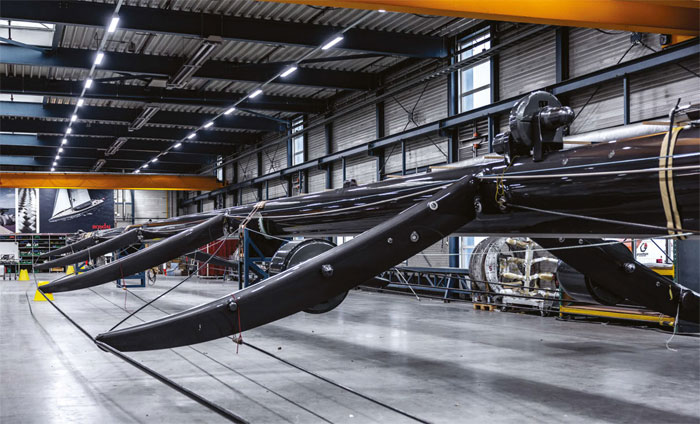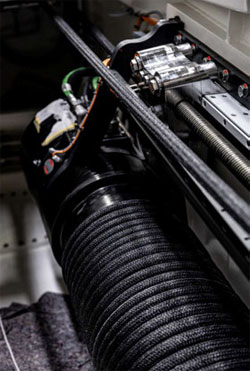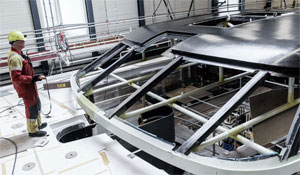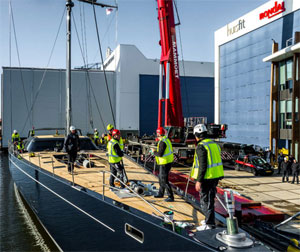
Rondal played a pivotal role throughout the design and engineering loops of the Nilaya project as well as building the deckhouse, cockpit, keel trunk, rig, sailing systems and more
Who do you call when you have a groundbreaking new concept for a superyacht that requires a performance rig, integrated sailing system and a wide range of carbon components? For the 47-metre (154ft) Reichel/Pugh-Nauta sloop Nilaya, the choice of a partner with the required expertise in design, engineering and fabrication of hitech sailing systems and marine carbon composites was obvious. It was a job for Rondal.
Constructed at the Royal Huisman shipyard in The Netherlands – the first yacht produced with their innovative new Featherlight methodology – and due for delivery to her owners around the time this issue of Seahorse went to press, the new Nilaya is by a clear margin the lightest-displacement aluminium sailing superyacht ever built. Her polars suggest that she’ll be quite capable of challenging carbon composite superyachts in bucket regattas, even though she is primarily conceived as a longdistance cruiser.
Selected to produce the carbon fibre components of Nilaya’s hybrid hull, as well as supplying her highmodulus carbon mast, furling boom, fully integrated sailing systems and more, Rondal was involved in the project from an early stage onwards. Engineers from Rondal played the key role of sailing system integrator in Royal Huisman’s finite element analysis (FEA)-driven Featherlight approach, ensuring the optimisation of all the carbon composite components in the hull and deck, as well as the entire rig, and supporting the process throughout.
Many of the aluminium-hulled superyachts built in recent years have some carbon components but Nilaya takes it to a whole new level. Her keel trunk, for example, is a complex structure with laminations that are more than 65mm thick, manufactured with extreme precision – tolerances of 0.3mm – to ensure that the yacht’s ultra-high aspect lifting keel can operate smoothly, even when sailing upwind when it is subjected to very high loads.
The carbon mould for the keel trunk was precision-milled across complex contours and the final component required multiple cures, due to the unusual depth of laminations that was needed to create a structure strong enough to withstand the colossal forces that could potentially act upon it if the yacht were to run hard aground. Even so, the end result is a remarkably slim and ultra-lightweight keel trunk that contributes a significant weight saving to Nilaya’s displacement while also having a minimal impact on the yacht’s internal layout and interior design.

Above: Rondal’s new captive reel winches weigh only half as much as their equivalent predecessors
Rondal also produced the deckhouse and main cockpit, with its integrated seating, as a single piece of prepreg composite superstructure measuring 17.5m by 7m, which when bonded to the hull contributes a significant amount of additional stiffness.
Another large composite structure built by Rondal is designed to serve several purposes on the foredeck. A secure, recessed stowage bay for Nilaya’s main guest tender when she is on passage in cruising mode, it converts into a spacious lounge area when the yacht is anchored, with a broad expanse of daybed cushions and seating around three sides of a table. With the tender and cushions removed and lids fitted, it becomes a part of the flush foredeck.
Among the other deck components that Rondal produced for Nilaya are the custom housing of the twin-steering pedestals, the lazarette, the crew companionway and the removable hardtop bimini that shelters and shades the passenger cockpit. Ten hydraulic deck winches – two on each side of the sailing cockpit, two on the aft deck and four clustered around the base of the mast – were also supplied, along with eight flush, custom skylight hatches in the foredeck and various pieces of titanium hardware.
Under the deck, Nilaya’s sail-handling hardware includes Rondal’s new design of lightweight, hydraulically operated captive reel winches, which combine an aluminium chassis with a filamentwound carbon fibre drum. Exceptionally powerful and proven to withstand very high loads, these winches weigh only half as much as the previous generation of captive reel winches. They are also available as electric-powered variants with innovative peak shaving technology that feeds power back into the yacht’s batteries. However, for a long-distance ocean cruising yacht like Nilaya that is expected to spend long periods of time in remote parts of the world, the relative simplicity of a more conventional hydraulicpowered winch setup has obvious advantages. Rondal’s line feeders work in step with the captive winches, providing continuous line tension to ensure a perfect tight coil around the drum.
Also under the deck – in this case the foredeck – are a couple of Rondal’s sail drums. These are designed to enable faster, easier and safer launching and retrieval of large downwind sails by a relatively small crew, in Nilaya’s case allowing big A-sails to be used more often on ocean voyages and also to be stowed securely when not in use.

Above: the cabin top for Nilaya breaks new ground for superyacht engineering, being both light in weight and contributing substantially to the yacht’s global stiffness.
Below: the yacht’s mast is stepped by Rondal staff at Huisfit

Rondal’s participation in this project also included a key role in the design and engineering loops for the yacht’s aero package, working closely with Reichel/Pugh and Doyle Sails. ‘Bringing in the mast and sail designers early in the process has significant advantages,’ naval architect Jim Pugh explains. 'From the aero CFD side, Rondal and Doyle shared high-quality data about sail forces and sail loads that we integrated into the hydro CFD studies of the candidate hulls. This markedly improved the quality of the CFD hull testing and the resultant performance prediction. The mast and sail loads were then input into the hull and deck’s structural engineering. These studies are applicable to any design whether Featherlight or heavy. No matter the thickness of the plate or weight of the composite, such a study will yield remarkable results.’
Royal Huisman’s Featherlight construction methodology is a holistic approach that encompasses the rig as well as the hull. One of Rondal’s major contributions to the weight-saving success of this project, working with Doyle and Reichel/ Pugh, was a new arrangement of running backstays that saves an impressive 1,200kg.
Nilaya is the first yacht in the 150ft size range that is designed specifically to take full advantage of the Structured Luff sail technology pioneered by Doyle Sails. This choice allowed the entire Rondal rig – including the Panamax mast and various other components – to be built significantly lighter, saving weight in places where it has the greatest impact on the yacht’s performance and motion in a seaway. For example, tapering the top of the mast on all four sides and eliminating the need for a headboard lock in favour of a hook to capture and hold the head of the mainsail saved 150kg at the masthead, which might not sound like a lot given the very large size of this yacht, but in that position it actually has a measurable positive impact on her centre of gravity.
The most obvious innovation on Nilaya’s mast is the curved shape of her spreaders. While it does look stylish, the purpose of this new design from Rondal is purely functional. It allows a slightly larger genoa that is fuller in the leech to have a tighter sheeting angle.
Towards the end of February, Nilaya’s completed rig was delivered to Royal Huisman’s facility in Amsterdam, where Rondal engineers supervised the stepping of the mast. Back at headquarters in Vollenhove, the design office was already preparing for an even larger project – one that requires Rondal yet again to enlarge its composite mast construction and curing facility. An order has been received to build the mast for a yacht that is set to be the world’s largest sloop, once again due to be built by Royal Huisman: the 85-metre (280ft) Project 410. And it’s only a matter of time before another client turns up with even higher ambitions.
Click here for more information on Rondal »
We invite you to read on and find out for yourself why Seahorse is the most highly-rated source in the world for anyone who is serious about their racing.
To read on simply SIGN up NOW
Take advantage of our very best subscription offer or order a single copy of this issue of Seahorse.
Online at:
www.seahorse.co.uk/shop and use the code TECH20
Or for iPad simply download the Seahorse App at the iTunes store


